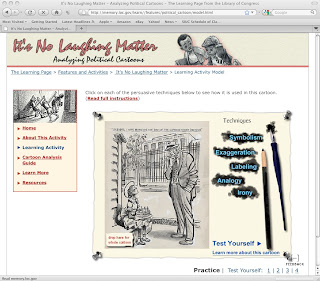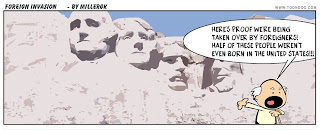Social Sciences
Political cartoons show up a lot in social studies curricula, including textbooks, worksheets, and now standardized state and national exams. In these cases, students are asked to analyze the cartoon's content or the cartoonist's point of view. In classroom instruction, teachers might try to "diversify" their instruction and have students create their own cartoon related to a historical or current event. The following sources provide some guidance for one way to include political cartoons as an authentic and legitimate part of any social studies teacher's instruction.
 No Laughing Matter from the Library of Congress
No Laughing Matter from the Library of Congress
As a way to teach critical thinking, the Center for Media Literacy has built a curriculum around five key questions. All of these queries apply to analyzing any source--an advertisement, a newspaper article, or a political cartoon--but an important question is #2, "What creative techniques are used to catch my attention?" To further conceptualize this analysis, the Library of Congress has created a web-based activity, "No Laughing Matter," to help students evaluate cartoons with five basic concepts: Labeling, Irony, Analogy, Exaggeration, and Irony. I point out these concepts because they provide a helpful framework students can apply to any cartoon (or written source, for that matter). For example, "How does this cartoonist use irony to illustrate her point of view?"
 Created at Toondoo (click image to enlarge it)
Created at Toondoo (click image to enlarge it)
Finally, students need not be a professional artist to create stunning political cartoons. A free online tool, Toondoo Maker, on the Toondoo site allows them to select from hundreds of images to construct their own visual commentary on a historical or current event. Teachers can then require their students to describe how they used irony or analogy to make a visual argument. I've uploaded an example I recently created on the topic of immigration.
- Back To School (with Common Core, Historical Thinking, Rti, Parcc...)
Yikes. It looks like I have been on a bit of a hiatus and not keeping up with posts about resources... Anyway, I recently emailed some newer resources with a former student who graduated in 2010 and is now gainfully employed at a great school (congrats...
- Viz. A Blog For Media Literacy Pedagogy
via viz While doing an image search for an unrelated project, I came across this informative blog, vis. Visual Rhetoric, Visual Culture, Pedagogy, from the University of Texas. As the subtitle explains, this blog has a nicely arranged series of posts...
- Examining Photographs: "migrant Mother"
Cover Image via NPR.org Analyzing Photographs In previous posts, I have identified resources that help students analyze images through the lens of media literacy. A recent NPR Morning Edition interview with the author of the new book Dorothea Lange: A...
- Kate Brigham On Media Literacy
Here, the learner can manipulate the size, color, and "wash" (in this case red) for the image used to accompany a news article. Above is the original photograph that accompanied the article titled, "Why Do They Hate Us?" It's interesting how the...
- Urls For Creating Art, Comic Strips, Newsletters...
Here are a few of my favorite free programs for creating digital cartoon strips, collages, and other images. Collage Maker I (Collage) Collage Maker II (Collage) Creating a Still Life (Still Lifes) ToonDoo (Comic Strips) Letter Pop (Newsletters)...
Social Sciences
Teaching with Political Cartoons
Political cartoons show up a lot in social studies curricula, including textbooks, worksheets, and now standardized state and national exams. In these cases, students are asked to analyze the cartoon's content or the cartoonist's point of view. In classroom instruction, teachers might try to "diversify" their instruction and have students create their own cartoon related to a historical or current event. The following sources provide some guidance for one way to include political cartoons as an authentic and legitimate part of any social studies teacher's instruction.
 No Laughing Matter from the Library of Congress
No Laughing Matter from the Library of Congress Created at Toondoo (click image to enlarge it)
Created at Toondoo (click image to enlarge it)- Back To School (with Common Core, Historical Thinking, Rti, Parcc...)
Yikes. It looks like I have been on a bit of a hiatus and not keeping up with posts about resources... Anyway, I recently emailed some newer resources with a former student who graduated in 2010 and is now gainfully employed at a great school (congrats...
- Viz. A Blog For Media Literacy Pedagogy
via viz While doing an image search for an unrelated project, I came across this informative blog, vis. Visual Rhetoric, Visual Culture, Pedagogy, from the University of Texas. As the subtitle explains, this blog has a nicely arranged series of posts...
- Examining Photographs: "migrant Mother"
Cover Image via NPR.org Analyzing Photographs In previous posts, I have identified resources that help students analyze images through the lens of media literacy. A recent NPR Morning Edition interview with the author of the new book Dorothea Lange: A...
- Kate Brigham On Media Literacy
Here, the learner can manipulate the size, color, and "wash" (in this case red) for the image used to accompany a news article. Above is the original photograph that accompanied the article titled, "Why Do They Hate Us?" It's interesting how the...
- Urls For Creating Art, Comic Strips, Newsletters...
Here are a few of my favorite free programs for creating digital cartoon strips, collages, and other images. Collage Maker I (Collage) Collage Maker II (Collage) Creating a Still Life (Still Lifes) ToonDoo (Comic Strips) Letter Pop (Newsletters)...
